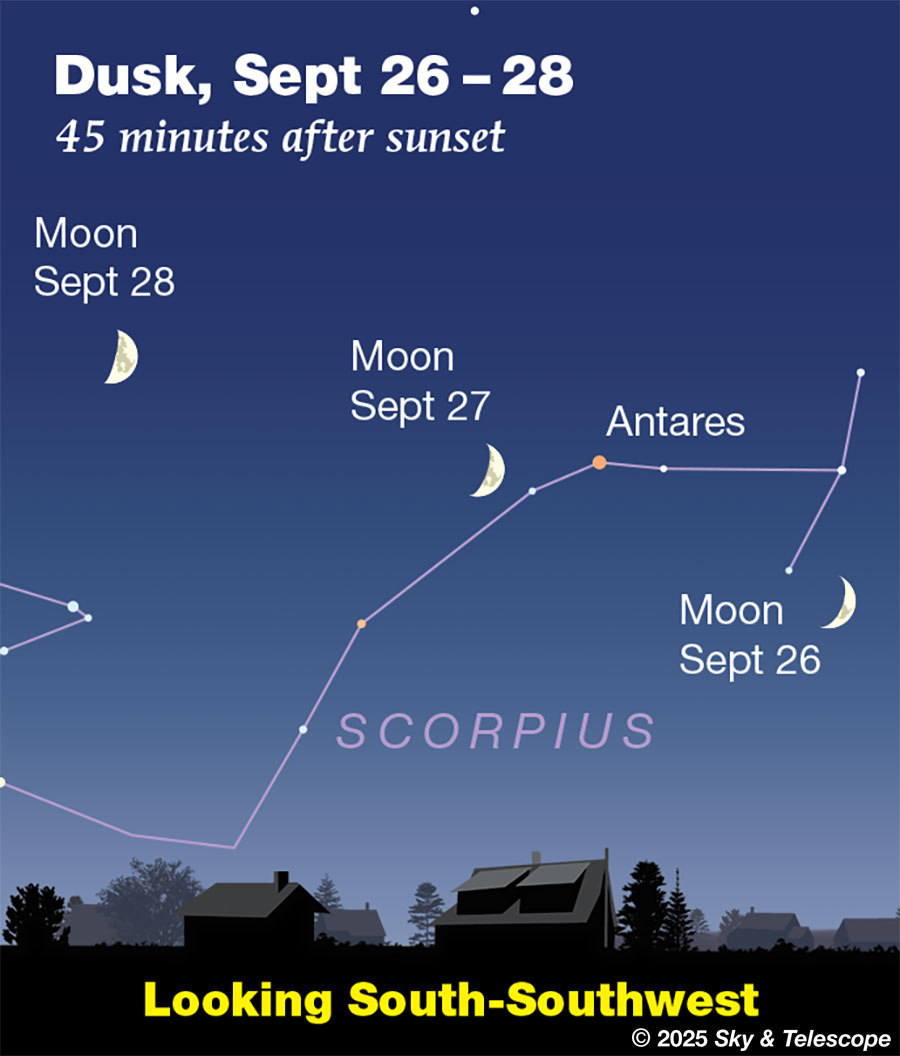Special to CosmicTribune.com, September 21, 2025
Excerpts from weekly Sky&Telescope report.
MONDAY, SEPTEMBER 22
■ Fall begins today in the Northern Hemisphere at the moment of the equinox, 2:19 p.m. EDT (11:19 a.m. PDT). This is when the center of the Sun crosses Earth’s equator, and equivalently the celestial equator, in its six-month journey south from solstice to solstice.
■ Coincidentally, as if to mark this transition every year, Deneb is taking over from brighter Vega as the zenith star after nightfall (for skywatchers at mid-northern latitudes).
■ For evening observers the annual Algol eclipse season has begun. The prototype eclipsing variable star should be at minimum brightness, magnitude 3.4 instead of its usual 2.1, for about two hours centered on 11:01 p.m. EDT (8:01 p.m. PDT). Algol takes several additional hours to fade and to rebrighten.
At any random time you glance up at Algol, you have a 1-in-30 chance of catching it at least 1 magnitude fainter than normal.
TUESDAY, SEPTEMBER 23
■ Arcturus shines in the west these evenings as twilight fades out. Capella, equally bright, is barely rising in the north-northeast (depending on your latitude; the farther north you are the higher it will be.) They’re both magnitude 0.
Later in the evening, Arcturus and Capella shine at the same height in their respective compass directions. When will this happen? That depends on both your latitude and longitude.
When it does, turn around and look low in the south-southeast. There will be 1st-magnitude Fomalhaut at about the same height too — exactly so if you’re at latitude 43° north (from Boston to Buffalo, Milwaukee, Boise, Eugene). Seen from south of that latitude, Fomalhaut will appear higher than Capella and Arcturus. Seen from north of there, it will be lower.
WEDNESDAY, SEPTEMBER 24
■ The asteroid 1 Ceres, the largest and first discovered, is nearing its October 2nd opposition. It’s in binocular range at magnitude 7.6 this week and next, near Eta Ceti. Use the finder chart in the October Sky & Telescope, page 50. The tick marks on its path there are for 0:00 UT on the dates indicated, which falls on the evening of the previous date for the Americas.
THURSDAY, SEPTEMBER 25
■ Arcturus shines ever lower in the west-northwest after dark. The narrow kite shape of its constellation, Boötes, extends two fists at arm’s length to Arcturus’s upper right. Arcturus is where the kite’s downward-hanging tail is tied on.
To the right of Boötes, the Big Dipper is turning more level.
And this is the time of year when, during the evening, the dim Little Dipper “dumps water” into the bowl of the Big Dipper way down below. The Big Dipper will dump it back in the evenings of spring.
■ Cygnus the Swan floats nearly straight overhead these evenings. Its brightest stars form the big Northern Cross.
Face southwest and crane your head way, way up, and the cross appears to stand upright. It’s about two fists at arm’s length tall, with Deneb as its top. Or to put it another way, when you face southwest the Swan appears to be flying downward along the Milky Way.
SATURDAY, SEPTEMBER 27
■ At nightfall, the waxing crescent Moon shines about 3° or 4° left of orange Antares in upper Scorpius as shown below. The whole stick-figure Scorpion is tilting and lying down on its way out for the season.
The low waxing Moon passes the head of Scorpius. The best view will actually be in a darker sky than this, near the end of twilight: maybe 75 minutes after sunset. But you’ll need a clear horizon in this direction.
SUNDAY, SEPTEMBER 28
■ Now the Moon shines above the Cat’s Eyes pair of stars in the tail of Scorpius, shown above. The pair is a little less than a fist at arm’s length below the Moon.


You must be logged in to post a comment Login